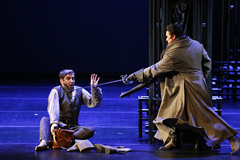| Opera Reviews | 25 April 2024 |
Dargomyzhsky's The Stone Guest premieres at the Bolshoiby Silvia Luraghi |
|
| Dargomyzhsky: The Stone Guest Bolshoi Theatre 20 May 2016 |
|
|
Dargomyzhsky’s opera is based on Pushkins’s play by the same name, which constitutes with very limited adaptation the libretto. In his turn, Pushkin wrote his ‘Little Tragedy’ after seeing Mozart’s Don Giovanni and partly inspired by it, but bringing his romantic view to the play, which focused on the tragic elements of Mozart’s and Da Ponte’s dramma giocoso (farcical drama). Dargomyzhsky in his turn wrote a highly innovative opera, with virtually no arias except for Laura’s two romanzas, which however cannot be considered arias in the traditional sense, because they are performed as songs by Laura. Wagner’s influence has often been said to have prompted Dargomyzhsky to compose his music with the declamato stye of singing. According to Anton Grishanin, who is conducting the current production, this is not really the case, as Wagner was still relatively little known at the time of composition. Dargomyzhsky died in 1869, leaving the opera unfinished. Following his will, Cesar Cui and Nikolai Rimsky-Korsakov completed the work, which then premiered in 1872. Later, Rimsky-Korsakov wrote two new orchestrations, the last of which premiered in 1906, and is now the standard version of the opera. It was also the version chosen for this new production, after the conductor and the stage director carefully went through all versions of the score. With the aid of set designer Viktor Shilkrot and of costume designer Irena Belousova, director Belyanushkin staged the action in a dim looking setting, in which ascending metal structures hosted a thick crowd of monks, remindful of the several Gothic cathedrals of Spain. The lower part of the scaffolding offers the setting for Laura’s room in the second scene of the first act, as well as Anna’s cell in the third act. The nocturnal atmosphere created by light designer Evgeny Vinogradov left no doubts that even the cheerful singing of Laura were just the prelude to tragedy. The cast featured a number of very well prepared young singers, among them the notable Don Juan of tenor Sergey Radchenko, confronted in the first act by equally impressive baritone Alexander Miminoshvili as Don Carlos. Soprano Ekaterina Morozova, from the company’s Young Artists Program, was a temperamental Donna Anna and mezzo Oksana Volkova as Laura displayed a beautifully colored voice in her two songs. All singers and musicians were greeted with well deserved applause at the end.
|
|
| Text ©
Silvia Luraghi Photo © Damir Yusupov / Bolshoi Theatre |

 In 2002, Moscow’s Bolshoi Theatre was given a second stage in a building on the nearby square, which, after the historical stage’s renovation, is now used for titles that are likely to attract a smaller audience. In this way, the company runs a double season, with the two stages featuring different performances almost every night. The smaller theater offers a perfect venue for chamber operas, such as Alexander Dargomyzhsky The Stone Guest (Kamenny gost’), which is presently being shown in a new production by the young director Dmitri Belyanushkin.
In 2002, Moscow’s Bolshoi Theatre was given a second stage in a building on the nearby square, which, after the historical stage’s renovation, is now used for titles that are likely to attract a smaller audience. In this way, the company runs a double season, with the two stages featuring different performances almost every night. The smaller theater offers a perfect venue for chamber operas, such as Alexander Dargomyzhsky The Stone Guest (Kamenny gost’), which is presently being shown in a new production by the young director Dmitri Belyanushkin. 





